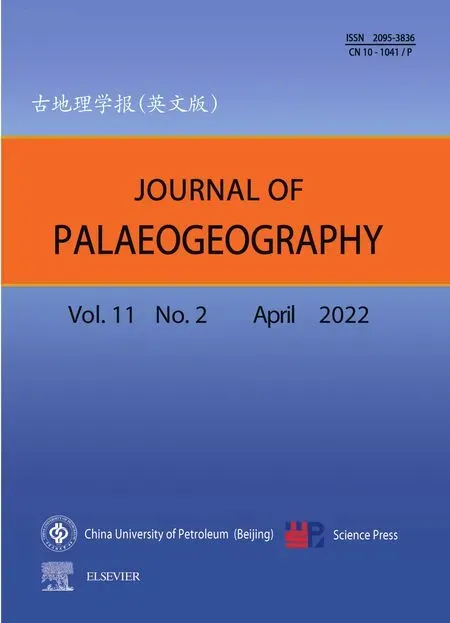Detrital zircon ages of Oligocene to Miocene sandstone suites of the Southern Apennines foreland basin system, Italy
2022-06-10AnnmriFornelliFrncescMichelettiSlvtoreGllicchioFrizioTursiSrCrinitiSlvtoreCritelli
Annmri Fornelli , Frncesc Micheletti ,*,Slvtore Gllicchio , Frizio Tursi , Sr Criniti ,Slvtore Critelli
a Dipartimento Scienze Della Terra e Geoambientali,Universitˋa Degli Studi“Aldo Moro”Bari,Via E.Orabona,4,70125, Bari, Italy
b Dipartimento di Biologia, Ecologia e Scienze Della Terra, Universitˋa Della Calabria, Via Pietro Bucci, 87036,Arcavacata di Rende, Cosenza, Italy
Abstract U—Pb spot ages on detrital zircons from turbidite quartzarenites, quartz-feldspathic and volcaniclastic sandstones of the Tufiti di Tusa(TTF),Numidian Flysch(NF),Bifurto(BF),Gorgoglione(GF)and Serra Palazzo (SPF) formations, exposed in southern Italy, were detected to define their provenance signatures aiming to contribute to reconstructing the complex geodynamic evolution of the southern Apennine chain.The deposition ages of these sandstones range from Rupelian (TTF), Burdigalian p.p. -Early Langhian (NF and BF)and Langhian-Serravallian -Early Tortonian (GF and SPF). The detrital zircon ages in each deposit show different clusters.In TTF,the zircon age clusters are:610±6 Ma;390±4 Ma;287±3 Ma;157±2 Ma;78±1 Ma and 67 ± 1 Ma; 33 ± 1 Ma. In NF and BF formations, the prevalent zircon ages are clustered at 661 ± 10 Ma,607 ± 8 Ma and 547 ± 8 Ma. In GF sandstones, the ages of detrital zircons are clustered around 672 ± 28 Ma,458 ± 9 Ma, 297 ± 8 Ma and 24 ± 1 Ma. The sandstones of SPF contain zircons showing age clusters at 649±10 Ma,486±7 Ma and 315±5 Ma.Zircons and lithic fragments from TTF display a dominant provenance from Oligocene calc-alkaline effusive products located on western domains of the Mesomediterranean Microplate, and minor detritus from granitoids and metamorphic rocks of Variscan ages. Zircons of NF and BF indicate a provenance of detritus from the African Craton without evidence of Variscan or Alpine signatures.Zircons from GF and SPF show a provenance from both Variscan crystalline basement rocks forming the Alpine chain (Calabria-Peloritani Terranes) and Variscan magmatic and metamorphic rocks unaffected by Alpine tectonics, similar to Sardinia—Corsica (pro-parte) block. In addition, the Oligocene magmatic component dated at 24 Ma in GF sandstones is evidence for the maximum age of sedimentation for these deposits.In light of the recent and preliminary geochronological data acquired,a revised paleogeographic restoration could be inferred for the location of sedimentary basins during the Apennines tectonic evolution. The Rupelian sedimentation age of TTF suggests that the deposition domains of the Numidian sequences and the successive deposits of GF and SPF,were located in a more complex paleogeographic scenario along the orogenic system.
Keywords U—Pb detrital Zircon ages, Provenance of sandstones, Southern Apennine chain, Southern Circum-Mediterranean paleogeography
1. Introduction
Evidences of tectonic-sedimentary events preserved within the clastic sequences of the Apennine Chain record the timing of its evolution since breakup of Pangea. The tectonic processes include consumption of Tethys oceanic lithosphere and the clastic sequences can be used to check the successive stages of development of the accretionary orogenic system.The composition and stratigraphic relations of thick sedimentary sequences reflect a complete record of detritus provenance in the sedimentary basins of the circum-Mediterranean area during Europe and Africa convergence, which was also complicated by the role of other microplates. Tracking of the sedimentary evolution can be useful to define the paleogeography in the southern Mediterranean area.
In the last twenty years, many research studies have detailed the stratigraphic and structural characteristics of the southern Apennine clastic sequences(e.g. Pescatore et al., 1999; Patacca and Scandone 2007; Sabato et al., 2007; Guerrera et al., 2019).Investigation of the petrographic and chemical signatures of sandstones and interbedded mudrocks, have added new highlights into the definition of the paleogeographic setting as well (Fornelli et al., 1992;Fornelli and Piccarreta 1997; Critelli et al., 2017;Critelli 2018).
To constrain the evolution of the detritus’ source area for diverse stratigraphic sections,the distribution patterns of detrital zircon ages obtained through LAICP-MS analysis (Jabaloy-Sˋanchez et al., 2018;Armstrong-Altrin et al., 2020, 2021), could produce helpful results. A relevant contribution was provided by studies on sediment dispersal pathways associated with their timing evolution from key sequences in the northern Apennines chain, using U—Pb spot ages on detrital zircons. In the last years, some geochronological data were collected in the southern Apennines chain, providing new constraints on its palaeogeographic and palaeotectonic evolution (Fornelli et al.,2015, 2019; 2020a, 2021).
The detrital sequences considered in this work characterize the southern Apennines chain(Fig.1);they include the upper part of the Sicilide Unit represented by the Tufiti di Tusa Formation,different portions of the Numidian Flysch and the arenaceous successions of the Gorgoglione and Serra Palazzo Formations. The depositional ages of these sandstones vary from Rupelian-Burdigalian (Tufiti di Tusa), Burdigalian-early Langhian(Numidian Flysch and Bifurto Formation) up to Langhian-Tortonian (Gorgoglione and Serra Palazzo formations). In the following, a synthesis of stratigraphic data and U—Pb detrital zircon ages previously collected for these deposits is first proposed; these data, together with new ones for the Serra Palazzo sandstones, are then used to constrain a paleogeographic model for the evolution of the southern Apennines chain.
The state-of-the-art of the central-western peri-Mediterranean Cenozoic basins/chains, including the collected geochronological U—Pb zircon data on detrital components in clastic successions of the southern Apennines, represents a reference point for geological research.
In Table 1, U—Pb spot age clusters obtained on detrital zircons from Tufiti di Tusa, Numidian Flysch,Bifurto and Gorgoglione formations derived from Fornelli et al. (2015, 2019, 2020a, 2021) are summarized together with new geochronological data collected on zircons from sandstones of Serra Palazzo Formation. The analytical procedures to separate the zircon grains from sandstones and to collect the LAICP-MS data are reported in Appendix 1 and Table S1(supplementary files).
2. Orogenic systems in the Mediterranean area
The Circum-Mediterranean orogenic systems are mainly related to the sequential closure stages of the Tethyan ocean basins (e.g. Perrone et al., 2006;Critelli et al.,2008,2017;Critelli 2018).The Alps and the Betic Cordillera represent north-west-vergent orogenic systems connected to the closure of the western Tethys ocean branch since the latest Cretaceous. The subduction towards south and east of the Iberian-European plates below an independent microplate detached from them during the Pangea breakoff (Mesomediterranean Microplate: Guerrera et al., 1993) generated N- and NW-vergent orogenic domains characterized by ophiolite sequences with metasedimentary covers affected by HP-LT metamorphism. The terranes involved in this orogen were originated by reworking of Variscan chain remnants containing Cadomian and Proterozoic-Cambrian signatures, together with eastern Tethys oceanic realm including deformed elements derived from Adria and Africa continental margins (Critelli, 2018). This orogenic system formed the precursor orogen of the internal domains of the Alpine Chain (AlKaPeCa,Bouillin et al.,1986),whose pieces are now scattered around the Mediterranean area in south Spain (Betic Chain), northern Italy (Alps), north-eastern Corsica,northern Africa (Internal Rif and Kabylias) and southern Italy (Calabria-Peloritani Terranes).
The south-eastern oriented orogenic system (or AlKaPeCa) was dislocated in the Mediterranean area during the successive closure of the eastern/southern branches of the Tethys ocean forming the Apennines and the Rift-Tell chains. The closure of the Betic-Maghrebide Flysch Basin, Lucanian and Ionian oceanic realm in the eastern Mediterranean area, due to subduction of Africa-Adria plates under the Mesomediterranean microplate, generated the southern Apennines chain. The closure of these eastern ocean branches of the Alpine Tethys during the Oligocene-Miocene formed the northern Africa orogen (Rif and Tell belts and Sicily) and the Apennine chain showing southern and north-eastern vergences, respectively(Critelli, 2018). The subduction towards west is still active today, as testified by the seismic activity along the Italy peninsula.During the Oligocene-Miocene,the rising orogenic areas of these chains, and their forelands provided abundant clastic detritus to the surrounding compressional and extensional syn-to lateorogenic basins. By monitoring the sedimentary evolution of the Lucanian, Maghrebian and Lagonegro basins from the Oligocene to the Late Miocene, an important contribution to paleogeographic reconstruction can be obtained.
3. Volcaniclastic sandstones in the southern Apennines (Tufiti di Tusa Formation)
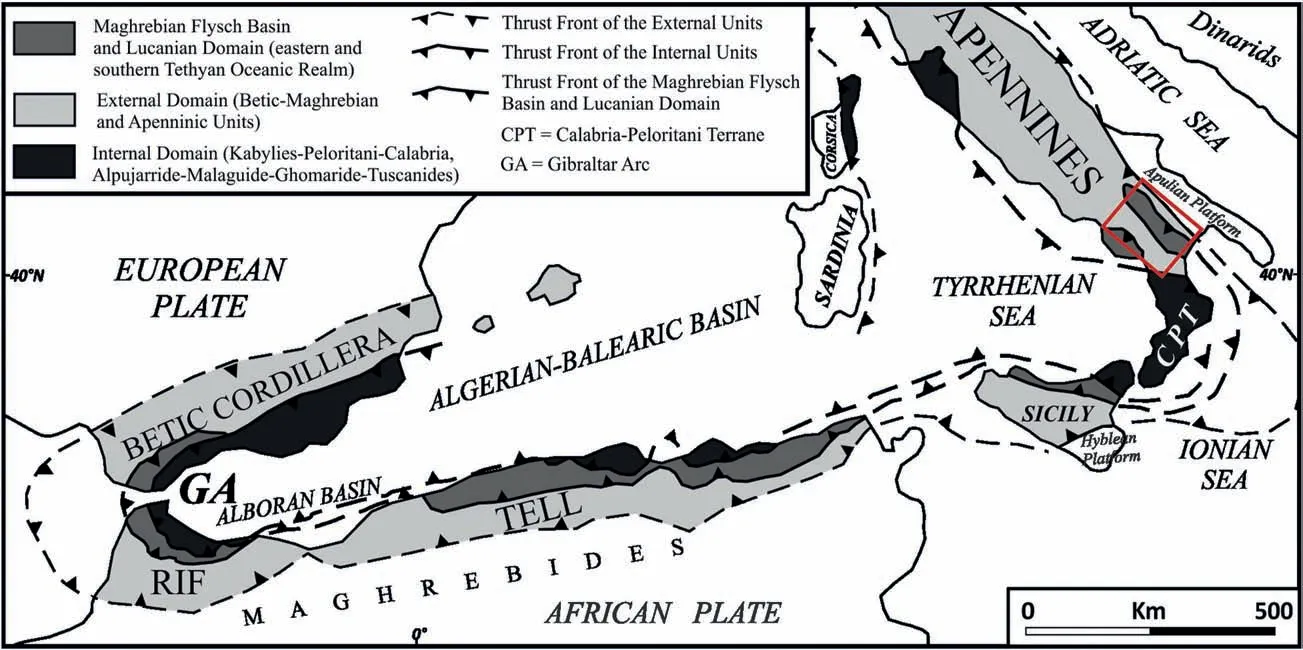
Fig. 1 Geological sketch map of the Circum-Mediterranean orogenic belts (from Critelli, 2018). The red box indicates the location of the studied area. The Maghrebian Chain includes the Rif Chain in Morocco, the Tell Chain in Algeria, and part of Sicily.

Table 1 Synthesis of the U—Pb detrital zircon ages from sandstones of the considered formations in southern Apennine chain(Serra Palazzo data in this study,the others from Fornelli et al.,2015,2019;2020a,2021).
These deposits consist of lithofeldspathic volcaniclastic sandstones belonging to the Sicilide Rocca Imperiale Tectonic Unit (Carbone, 2013). This tectonic unit is regionally subdivided into two tectonically stacked sub-units (Fig. 2), represented, from top to bottom, by the Torrente Cerreto sub-unit and the Corleto Perticara sub-unit. The Torrente Cerreto sub-unit shows a chaotic structure typical of a tectonic mˊelange. In contrast, the sedimentary succession of the Corleto Perticara sub-unit is well preserved and consists, from bottom to top, of the following formations (Fig. 2): Argille Varicolori Inferiori (Cretaceous-Paleocene), Monte Sant’Arcangelo Formation (Paleocene-Eocene), Argille Varicolori Superiori (Eocene-Oligocene), and Tufiti di Tusa Formation (Late Oligocene—Early Miocene) (Critelli et al., 1990; Perri et al., 2012; SGI, 2012; Carbone 2013; Matano et al., 2020). The sedimentation age has been debated in literature, it was indicated as Late Oligocene -Early Miocene by some authors (de Capoa et al., 2004, 2014; Critelli, 2018; Martin Martin et al., 2020) or as Late Eocene-Early Oligocene by Baruffini et al. (2002). The oldest possible sedimentation age of the Tufiti di Tusa Formation was also estimated by means of U—Pb dating of detrital zircon grains in one stratigraphic section of the Corleto Perticara tectonic sub-unit (Fig. 2) in the proximity of Rotondella Village (Fornelli et al.,2020a).
The Tufiti di Tusa Formation is a turbiditic succession,about 250 m in thickness,varying from carbonate turbidite strata to grey-green quartzolithic and volcaniclastic sandstones. The larger amount of the volcaniclastic detritus characterizes the middle and upper portions of the succession(Critelli et al., 1990;SGI 2012; Cerone et al., 2017). The sedimentary structures, at the base, of the volcaniclastic strata,correspond to flute and load casts, indicating a prevalent sediment dispersal pathway from S to N in present-day coordinates(Critelli et al.,1990;Fornelli et al., 1992; Fornelli and Piccarreta, 1997). However,the southern provenance becomes almost western, if the anticlockwise rotation of several tens of degrees of the southern Apennines toward the Adria plate is considered (Speranza et al., 2003a, 2003b; Fornelli et al., 2020a).
The age clusters recorded in the volcaniclastic sandstones from U—Pb zircon dating testifies different source of detritus (Table 1; Fig. 3):
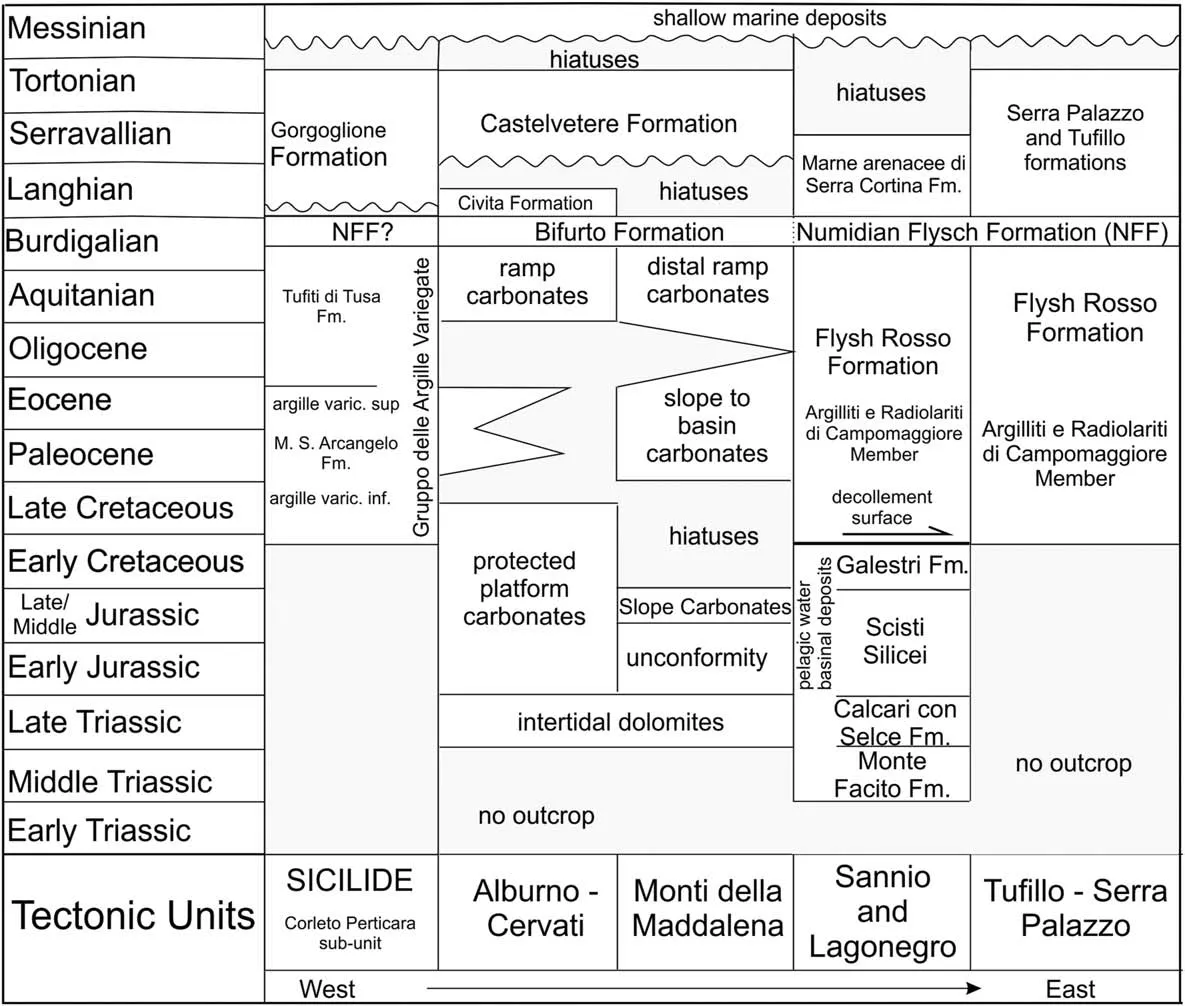
Fig. 2 Stratigraphic scheme from the Triassic to the Messinian and from West (left) to East (right) of the studied tectonic units in the southern Apennine chain (modified from Patacca and Scandone, 2007).
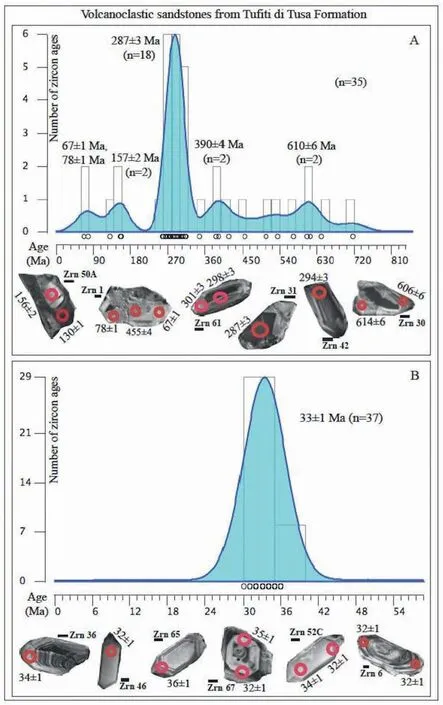
Fig. 3 Histograms with Kernell density estimates (Vermeesch, 2012) of the U—Pb spot ages from volcanoclastic sandstones of Tufiti di Tusa Formation.Variable Pressure Secondary Electron(VPSE)images of selected dated zircons are also shown;red circles indicate the spot location of concordant ages (modified from Fornelli et al., 2020a).
(1) some Paleoproterozoic—Neoarchean and Cambrian-Mesoproterozoic ages(2813 Ma-506 Ma,Table 1) indicate Cadomian terranes in the source area;
(2) a few Devonian—Ordovician ages(455-387 Ma)suggest a provenance from basements affected by Devonian-Ordovician tectonism connected to an Eo-Variscan orogenic phase (Fornelli et al., 2020a, 2021).
(3) a relevant age peak(287±3 Ma)corresponds to magmatic and metamorphic zircons derived from a chain formed during the last phase of the Variscan orogenesis (Fig. 3A).
(4) a few ages of 156 Ma,130 Ma,78 Ma and 63 Ma testify for provenances from ophiolites and blue amphibole-bearing rocks, related to the opening and closing of the Tethyan Ocean basins in the area, respectively (Fornelli and Piccarreta, 1997).
(5) The most relevant age peak corresponds to the Priabonian-Rupelian ages (Fig. 3B) obtained from euhedral zircons(31—36 Ma)with internal magmatic textures indicative of synsedimentary volcanic activity (Critelli et al.,2017; Fornelli et al., 2020a).
In brief, the U—Pb ages collected on detrital zircons and the mineralogical composition of the lithic fragments of Tufiti di Tusa volcaniclastic sandstones from the southern Apennines suggest a provenance from an active magmatic arc with calc-alkaline affinity located on a crystalline basement with a sedimentary cover(Critelli et al.,2017;Fornelli et al.,2020a).The high volume of volcanic detritus(approximately 70%of the sampled volcaniclastic beds) shows that the maximum syn-sedimentary volcanic input took place during the late Priabonian—early Rupelian (magmatic idiomorphic zircons with ages around 33 ± 1 Ma,Fig. 3B), indicating the maximum sedimentation age.
At regional scale, similar volcaniclastic signatures having abundant andesitic detritus are also found within the tectonic mˊelange of the Lucanian Oceanic Unit (Liguride Complex; Critelli, 1993) and interbedded with carbonate deposits of the Roccadaspide-Cerchiara Formation (Critelli and Le Pera 1995, 1998;Critelli,2018),evidence that volcaniclastic signatures range in age from the Rupelian to the Burdigalian.
4. Numidian and Bifurto quartzarenites
In southern Apennines, the deposition age of the Numidian and Bifurto quartzarenites is late Burdigalian-early Langhian (Fig. 2). They are parts of different tectonic units detached from their original paleogeographic domains and tectonically imbricated within the Apenninic accretionary wedge. Substantial difference between the sandstones of the two formations lies in the substrate of the depositional basins.The Numidian Flysch was deposited at the earliest stage of the foreland basin system developed since the late Oligocene in the old Lagonegro-Molise basin(Irpinian Basin, Pescatore et al., 1999) when the Apennine orogenic front moved eastwards onto the Apennine Platform areas (Critelli et al., 2011, 2017;Critelli and Criniti, 2021). Consequently, in the inner parts of the basin, the substrate of the Numidian Flysch consisted of Cretaceous to lower Miocene deepsea successions of the Flysch Rosso Formation (e.g.Sabato et al.,2007)deposited in the Lagonegro-Molise basin of the outer Adria margin. Nevertheless, the sandstones of the Bifurto Formation were laid on Lower Miocene calcareous ramp deposits of the Campania-Lucanian platform forming a marginal area at west of the old Lagonegro-Molise basin, in the innermost part of the Adria Margin. In particular, the Bifurto Formation lies on calcarenites of the Cerchiara Formation and passes upward to the quartzofeldspathic sandstones of the Civita Sandstone (e.g.Critelli and Le Pera,1995,1998).The Numidian Flysch represents, instead, the upper portion of the Cretaceous — Miocene sedimentary succession belonging to the Sannio and Tufillo-Serra Palazzo tectonic units passing upward to Langhian — Tortonian turbiditic successions of the Marne arenacee di Serra Cortina,Serra Palazzo, Tufillo and Flysch di Faeto formations(Fig. 2). In the southern Apennines, the Numidian Flysch sandstones prevail with respect to the Bifurto ones. However, the sandstones show the same characteristics: they consist of monocrystalline or polycrystalline quartz grains with rounded or angular shapes,and their principal composition is Q95-98F1.5-4.5L0.5for Bifurto Formation sandstones and Q87-98F0.2-12L0-4for Numidian Flysch, respectively (Fornelli et al.,2015, 2019). The whole rock chemistry indicates an ultra-mature detritus being the SiO2contents in the range 87—93wt%(Fornelli and Micheletti, 2021).

Fig. 4 Histogram with Kernel density estimate of the U—Pb spot ages from quartz-arenites of Numidian Flysch and Bifurto formations and VPSE images of selected dated zircons (modified from Fornelli et al., 2015, 2019).
All U—Pb detrital zircon ages measured on 104 grains from the two formations show quite similar age peaks falling in the range 2551 Ma-425 Ma (Table 1).The most frequent ages of zircons are at 547 ± 8 Ma,607±8 Ma,661±10 Ma and in the range 775—1160 Ma(Fig. 4). The absence of Paleozoic—Mesozoic detrital zircon ages excludes provenance from Variscan or Alpine chain crustal fragments. Consequently, a clear provenance from the western African craton located in southern domains was suggested(Fornelli et al.,2015,2019). Sandstones with similar compositions containing detrital zircons with ages ranging in the same time interval are present in the Numidian Flysch of the Rif-Tell chain in northern Africa where detrital zircon ages younger than Precambrian were not measured(Azidimousa et al., 2019; Abbassi 2020). In these domains, the thickness of the quartz-rich sandstones is relevant (about 1000 m thick) and gradually decrease towards north; its depositional age is considered latest-Aquitanian -early Burdigalian (Belayouni et al.,2012, 2013; Guerrera et al., 2012) i.e. older than in southern Italy. Relevant thicknesses of sandstones in about 1 Ma are evidence of rapid subsidence of the foreland basin system (D'Errico et al., 2014). “Mixed successions”including both immature litharenites and Numidian mature petrofacies occur in Betic-Rif orogen(Critelli et al.,2020)with thicknesses up to 2000 m and were reported even in some localities in southern Apennines with moderate thicknesses(D’errico et al.,2014). The U—Pb zircon ages from mixed successions obtained from Mˊerinide Facies in Morocco by Abbassi(2020), testify for the occurrence of age clusters around 32 Ma, 280 Ma, 450 Ma, in addition to a large Precambrian population between 500 Ma and 700 Ma,as well as a few ages at 800 Ma,1000 Ma and 2000 Ma,indicating a double provenance of detritus in the mixed successions, from both European and African domains. Mixed successions were deposited in a marginal part of the old Lagonegro-Molise basin affected by strong tectonic subsidence inducing high sedimentation rates in a short period of time (Abbassi, 2020).However, in the southern Apennine chain, younger ages of 425 Ma on zircons from quartzarenites have not yet been measured.
5. Quartzofeldspathic sandstones of the Gorgoglione and Serra Palazzo formations
The Gorgoglione Formation consists of deep marine turbidite successions deposited in the Middle-to the Late-Miocene wedge top basin system overlying mainlythe Sicilide Units(Fig.2).The Serra Palazzo Formation is formed by siliciclastic and calciclastic arenites deposited, onto the Numidian quartzarenites, in the Middle Miocene foredeep basin (Irpinian Basin,Pescatore et al., 1999). The deposits of these basins were incorporated to the eastern southern Apennine orogenic belt during late Neogene to the Quaternary due to the accretionary processes and the anticlockwise rotation of the chain system towards the Adria(Apulian) foreland (Cerone et al., 2021). The Gorgoglione Flysch lies onto the Sicilide Unit, whereas the Serra Palazzo Formation shows stratigraphic contact with the underlying Numidian Flysch and belongs to Tufillo Serra Palazzo tectonic unit(Fig.2).
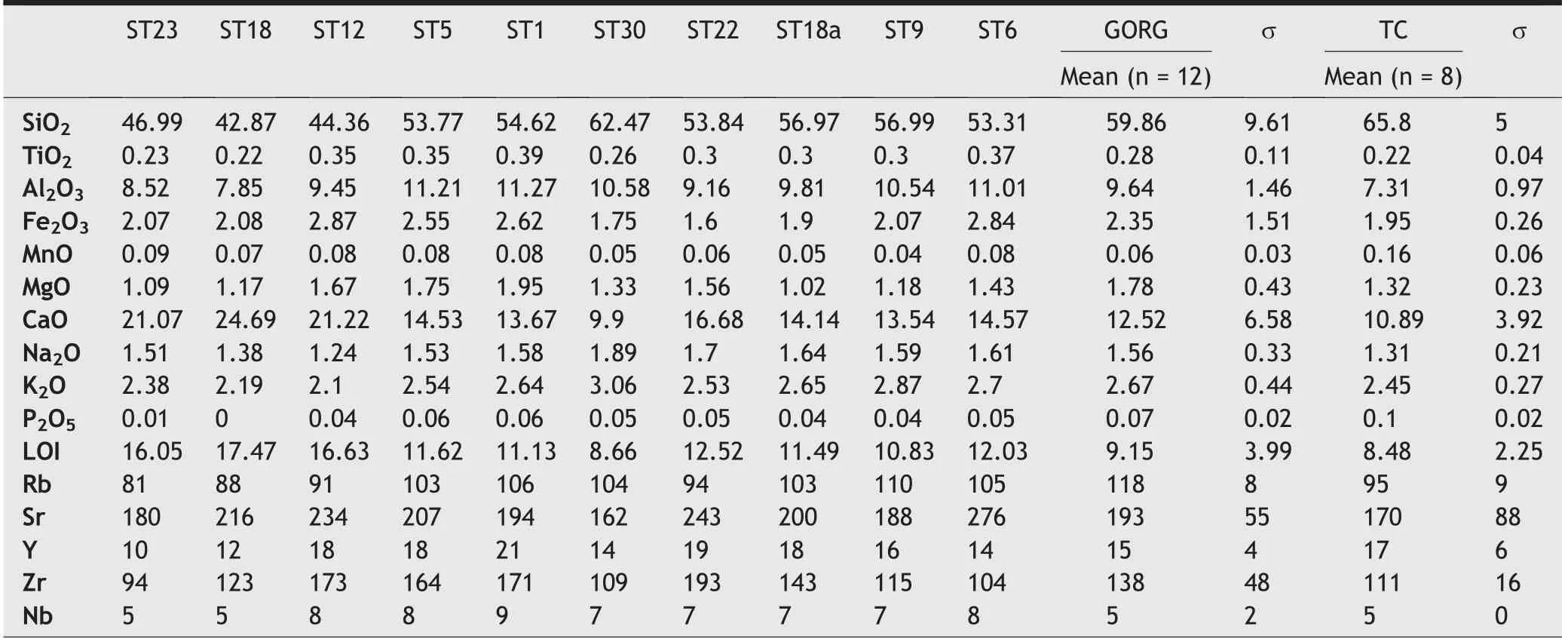
Table 2 Chemical analyses of Serra Palazzo sandstones(ST label,10 samples from two localities around Forenza Village,Potenza)and means of Gorgoglione sandstones(from two localities:Fiumarella di Gorgoglione,GORG label,near Gorgoglione Village,Matera;Torrente Casale,TC label,near Viggiano Village,Potenza).

Fig.5 Histogram with Kernel density estimate of the U—Pb spot ages from sandstones of Gorgoglione Formation with VPSE images of selected dated zircons (modified from Fornelli et al., 2021).

Fig.6 A)Microscope photos(crossed nicol)of Serra-Palazzo sandstones:(a)medium-grained sandstone with carbonate cement(CC)and Kfeldspars (Kfs); (b) micritic carbonate fragment(CL) and quartz grains (Qtz); (c) granitic lithic fragment(Gr); (d) lithic fragment of phyllite(Phy); B) Histogram with Kernel density estimate of the U—Pb spot ages from sandstones of Serra Palazzo Formation with VPSE images of selected dated zircons (original data).
Sandstones of the Gorgoglione Flysch are quartzofeldspathic in composition. Their composition consists of quartz, K-feldspar, plagioclase and micas; the phaneritic and aphanitic lithic fragments include granites, microgranites, phyllites, gneisses, micaschists,acidic and intermediate volcanic grains,extrabasinal carbonate fragments and cherts(Critelli and Le Pera, 1994, 1995, 1998; Fornelli et al., 2021). The principal composition ranges from feldspathoquartzose and lithofeldspatho-quartzose arenites (on average, Qt57F30L13from Fornelli et al., 2021). The chemical characters of sandstones (Table 2) show a prevalent siliceous composition(SiO2around 59.86 wt% along the section of Fiumarella di Gorgoglione and about 65.80 wt% along the succession of Torrente Casale) and variable CaO contents (12.52 wt % and 10.89 wt% on average, Table 2) related to modal contents of quartz, feldspar, micas and calcite.
The U—Pb detrital zircon ages obtained in the Gorgoglione Flysch define clusters at 672 ± 28 Ma,458 ± 9 Ma and 297 ± 8 Ma (Fig. 5); in addition, four zircon ages cluster at 24±1 Ma(Table 1;Fig.5).Only two ages at 576±8 Ma and 591±11 Ma have been found among the detrital zircon ages. The petrographic features indicate a provenance from a crystalline basement formed by low-medium-grade metamorphic rocks and granitoids covered by sedimentary successions on which an acidic volcanism occurred. These features together with U—Pb detrital zircon ages, are evidence that the main source area of the Gorgoglione Flysch sandstones can be traced back to terranes similar to the Sardinia—Corsica (pro-parte) block in which Ordovician—Silurian (485—419 Ma) and Carboniferous—Permian (358—254 Ma) magmatic and metamorphic rocks and Chattian volcanites occur(Franceschelli et al., 2005; Pavanetto et al., 2012).These deductions seem to be strengthened by the fact that Ediacaran ages are very scarce in the Gorgoglione sandstones,thus do not indicate a direct link with the Calabria-Peloritani Terranes, Betic Cordillera and Moroccan Mesetas where,on the contrary,ages falling in the range 562—526 Ma are very common (Fornelli et al., 2020b; Jabaloy-Sˋanchez et al., 2021; Accotto et al., 2021). Certainly, this interpretation could depend on limited sampling;but at this time,the only available data point to this interpretation. More extensive geochronological study of the Gorgoglione sandstones could bring new evidence about the provenance.
The Serra Palazzo sandstones consist of mediumgrained silica-clastic turbidites, amalgamated or separated by thin mud cups passing to fine-grained calci-clastic and silica-clastic turbidites covered by clayey marls of Toppo Capuana Formation. The deposition age of the succession has been indicated as Langhian-Serravallian (Gallicchio and Maiorano,1999; Cerone et al., 2021). New petrographic,chemical and geochronological data were collected on the Serra Palazzo sandstones in the southern Apennines (Appendix 1 and Table S1 supplementary files). Their mineralogical composition consists of quartz, K-feldspar, plagioclase and micas; the phaneritic and aphanitic lithic fragments include granites, gneisses, phyllites and micaschists, micritic and spatitic carbonate fragments (Fig. 6A), bioclasts and mud clasts. The sandstones are feldspatho-quartzose and litho-feldspatho-quartzose (Garzanti, 2019), and their mean composition determined on 16 samples is Qt63F28L9. The chemical characters of sandstones show a prevalent siliceous composition (SiO2around 52.62 wt % and Al2O3= 9.94 wt % on average) and variable CaO contents (from 9.90 to 24.69 wt % on average 16.40 wt%, Table 2) related to modal contents of quartz, feldspars, micas, silicate and carbonate lithics, and of calcite cement. The lower quartz contents and the higher calcite component with respect to Gorgoglione sandstones point to a mixed provenance represented by the forming Apennine chain, which provided a siliciclastic contribution and by a carbonate platform, which provided a calciclastic input.
The U—Pb age data obtained from detrital zircons in one sample (SP22) of the Serra Palazzo sandstones produced 28 valid age data (Table S1, supplementary file). The analytical methods and LA-ICP-MS system configuration (IGG-CNR, Pavia, Italy) were performed following the procedures indicated in Table S1 (supplementary file). The age distribution and the main clusters with some selected images of dated zircons are shown in Fig. 6B. It is evident that Carboniferous-Permian ages prevail clustering at 315 ± 15 Ma (16 ages ranging from 349 ± 5 Ma to 294 ± 4 Ma).Ordovician-Cambrian ages were also detected clustering around 486 ± 7 Ma (Fig. 6B). Three Cryogenian-Ediacaran ages at about 649 ± 10 Ma, a Tonian age at 819 ± 12 Ma and three Paleoproterozoic data(2514 ± 45—2040 ± 38 Ma) are also measured. Again,ages around 540 Ma are missing in these sandstones(Fig. 6B) as detected in Gorgoglione sandstones.
The overlap of the age distribution from Gorgoglione and Serra Palazzo sandstones (Figs. 5 and 6B)indicates a similar provenance for the silicic component represented by the front of building southern Apennine chain in the north-western Mediterranean area. As well as for Gorgoglione sandstones a crystalline basement similar to the Sardinia—Corsica (proparte) block could represent the source area of siliciclastic detritus also for Serra Palazzo sandstones.
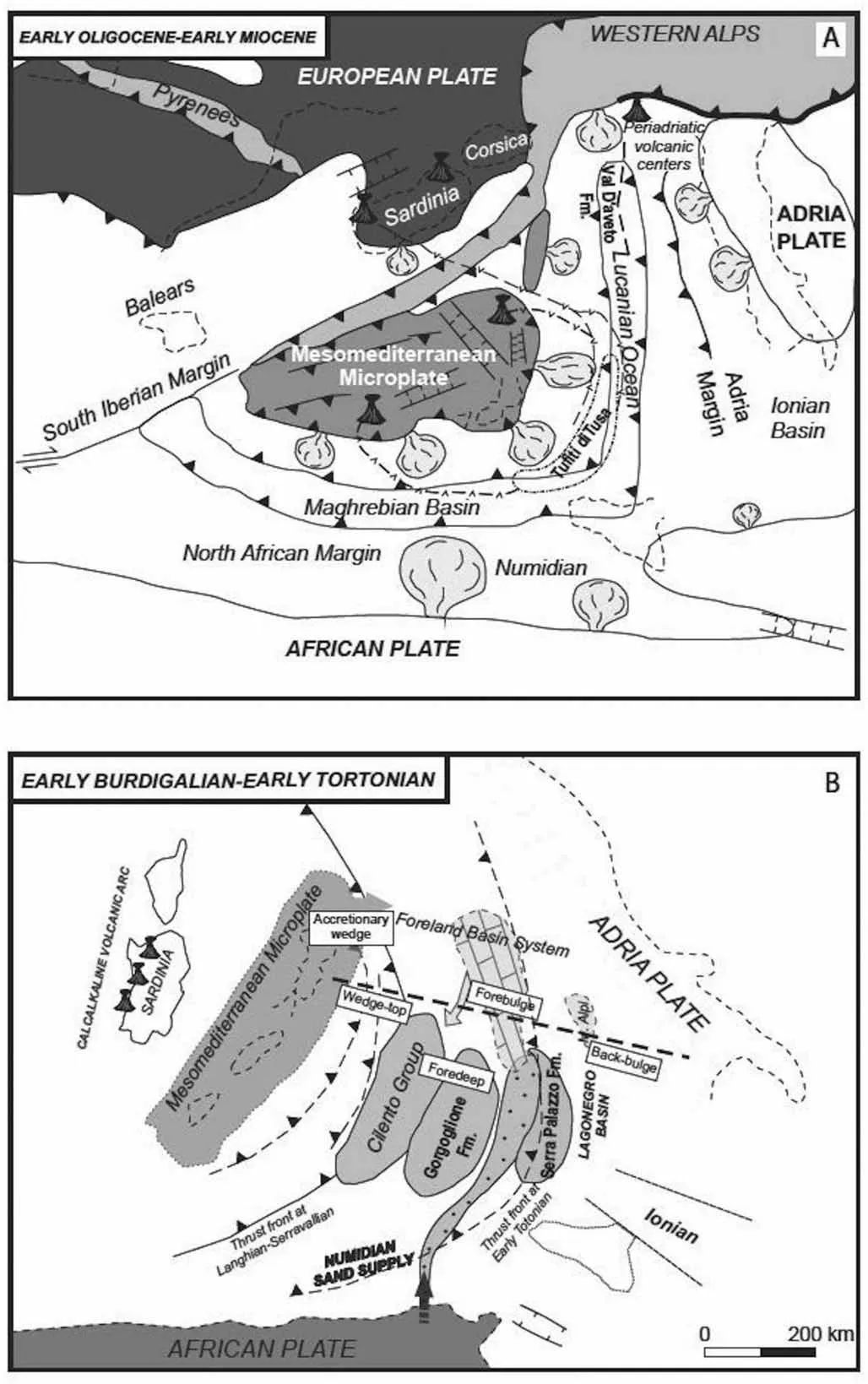
Fig.7 Palaeotectonic map of the central Mediterranean area in Early Oligocene-Early Miocene(A)and Late Burdigalian-Early Tortonian(B).Modified from Critelli (2018).
6. Discussion: evolution of the sedimentary basins from Rupelian to Tortonian in southern Apennines
The stratigraphic, petrographic, chemical and geochronological data collected in this study, on key turbidite quartzarenites, quartz-feldspathic and volcaniclastic sandstones exposed in the southern Apennines,allow us to infer the following paleogeographic scheme.
The timing record of the sedimentation events synthesized above occurred from the Rupelian to Tortonian, when the Apennines tectonics took place and detritus provenance changed accordingly. On the east side of a foredeep basin system facing the Mesomediterranean Microplate that was evolving to AlKa-PeCa (Bouillin et al., 1986), a syn-orogenic volcaniclastic detritus, dated at about 33 Ma (Fig. 3),was deposited. This volcanic detritus was integrated by two principal components: i) granitoids and lowmedium grade metasediments dated around 300 Ma;ii) ophiolitic and high-pressure metamorphic rocks linked to ages of 156 Ma and 73 Ma (Fornelli et al.,2020a).
A comparison of the maximum sedimentation age indicated by euhedral detrital zircons from Tufiti di Tusa sandstones with those of the syn-orogenic volcaniclastic detritus outcropping in the Mediterranean region, highlights broad similarities with the ages of the volcaniclastic sandstones of the Val d’Aveto—Petrignacola and Ranzano formations in northern Apennines(Mattioli et al.,2012;Di Capua et al.2016,2021; Malusˋa et al., 2016; Malferrari et al., 2020), as well as with those of the Taveyannaz sandstones deposited in the northern Alpine foredeep basin (e.g.Lu et al.,2019).During Late Eocene to early Miocene,the hinterland terranes of the Mesomediterranean Microplate facing the foredeep basins of the Lucanian-Maghrebian system composed a complexly structured source area. This area consisted of remnants of Variscan crystalline basement rocks with Cadomian orogenic cores, Alpine HP-LT ophiolites, blueschists and eclogites, and Priabonian-Rupelian volcanic edifices widespread in the Central Mediterranean area,close to Corsica,Provence (Di Capua et al.,2021)and north-east sectors of the Mesomediterranean Microplate (Amendola et al., 2016) (Fig. 7A).
Compressive tectonics were accompanied by subduction of the oceanic Lucanian basin and favoured the deposition of volcaniclastic syn-sedimentary sandstones. During Burdigalian in the southern-eastern realm of the old Lagonegro-Molise basin (Fig. 7B),Numidian sandstones (Burdigalian Langhian in age)were deposited in the foreland basin system. The provenance of these sediments was from the South(west African craton), as indicated for the quartzarenites in the Rif and Tell chains in north Africa(Azidimousa et al., 2019; Abbassi 2020) and Sicily(Critelli, 2018 and references therein). Consequently,from Burdigalian-Langhian, a prevalent southern provenance in Lagonegro-Molise basin produced Numidian sequences. However, the mixed successions(Mˊerinide Facies) formed by alternating beds of litharenites and quartzarenites, both in north Africa and southern Appenines (D’errico et al., 2014), indicate that this basin was also filled by detritus derived from dismantling of Variscan chain fragments located on the western site of the Mesomediterranean Microplate(or AlKaPeCa plate, Bouillin et al., 1986) in which Alpine orogen bordered the eastern margin. The mixed successions have a crucial significance because they seem related to exhumation and activation of thrusts along the active front of the Apennines, which migrated rapidly eastwards (Fig. 7B).
The different deformation stages that led to the closure of Lucanian and Lagonegro-Molise basins, in conjunction with provenance data,allow us to propose a new palaeogeographic scenario for the southern Apennines area during the Langhian-Tortonian,when a wedge top basin between the Apulia platform(external area) and the Apenninic internal zones,formed (Fig. 7B). This basin hosted clastic detritus from the rising Alpine chain that was undergoing exhumation on the western side, and carbonate sediments from the eastern domains. The Gorgoglione sandstones represent the prevalent supply from the west,while the Serra Palazzo arenites condensed both western and eastern provenances.
Indications about detritus sources also derive from the textures of the dated zircons(external morphology and internal zoning patterns). In particular, magmatic and metamorphic zircons showing peak cluster ages around 450 Ma and 300 Ma indicate a contribution from a middle-upper continental crust well represented in Sardinia—Corsica block.Considering the data collected so far, these cluster ages contrast with a direct provenance from the Calabria-Peloritani terrane,where age peaks at 540—550 Ma are prevalent (Fornelli et al.,2020b, 2021) and ages around 450 Ma are scarce.These ages are well represented even in Gorgoglione and Serra Palazzo sandstones(Figs.5 and 6B).Moreover,euhedral magmatic zircons dated at 24 Ma in Gorgoglione sandstones further indicate a Sardinia—Corsica provenance, where maximum magmatic activity took place during the Chattian.
7. Conclusions
The synthesis of formerly collected stratigraphic and geochronologic data, accompanied with new U—Pb spot age data on detrital zircons from the Serra Palazzo Formation, allowed us to propose a new geodynamic scenario for the evolution of the southern Apennines chain during Rupelian—Tortonian time.
Detrital zircon ages from the Tufiti di Tusa Formation indicate a sedimentation age corresponding to the Rupelian for the maximum of the volcaniclastic input;on thebasisofpetrographic,chemicalandgeochronological data,detritusinputsoccurredfromawesternareawhere a volcanic arc, probably located somewhere NE of the deforming Mesomediterranean Microplate,was active.
Similar data were collected on quartz-rich sandstones of Bifurto and Numidian Flysch formations deposited during Burdigalian — Early Langhian in foreland basins located on the Campania-Lucania platform(Bifurto) and between the Campania-Lucania and the Apulia platforms(Numidian Flysch).Detrital zircon ages of these quartz-arenites evidenced an exclusive source area located on the Africa Craton during Burdigalian-Early Langhian; therefore, the sedimentation in the foreland basins forming the future Apennine chain,did not take place at the expense of the detritus from the Alpine chain. Successively, in Langhian—Serravallian,important paleogeographic changes occurred; an extensive Maghrebian-Apennine thrust belt — foreland system in front of the building chain received prevalent detritus from Variscan crystalline basements similar to those of the Sardinia—Corsica block or the Calabria-Peloritani terrane,as well as from carbonate platforms scattered in the south-eastern area of the Mediterranean realm. Finally, age data collected on sandstones from Gorgoglione and Serra Palazzo formations indicate that their sources were located on the exhuming Mesomediterranean Microplate and on carbonate platforms providing detritus from eastern areas.
Conflicts of interest
The authors declare that they have no known competing financial interests or personal relationships that could have appeared to influence the work reported in this paper.
Funding
Funder: Universitˊa degli Studi di Bari Aldo Moro,Grant IDs: 00596609ricat01.
杂志排行
Journal of Palaeogeography的其它文章
- Basin-filling processes and hydrocarbon source rock prediction of low-exploration degree areas in rift lacustrine basins: a case from the Wenchang Formation in low-exploration degree areas, northern Zhu I Depression, Pearl River Mouth Basin, E China
- Provenance studies on the heavy mineral placers along the coastal deposits of Odisha,eastern India
- Sediment provenance of a carbonate bioclastic pocket beach — Le Dune (Ionian Sea, South Italy)
- Initiation and evolution of coarse-grained deposits in the Late Quaternary Lake Chenghai source-to-sink system: From subaqueous colluvial apron (subaqueous fans) to Gilberttype delta
- Tracking sources and paleotectonic settings of Mesozoic sandstones in interlinked rift basins of western India: An integrated approach using petrography and heavy mineral chemistry
- The primary dolostone in the Meso-Neoproterozoic: Cases study on platforms in China
